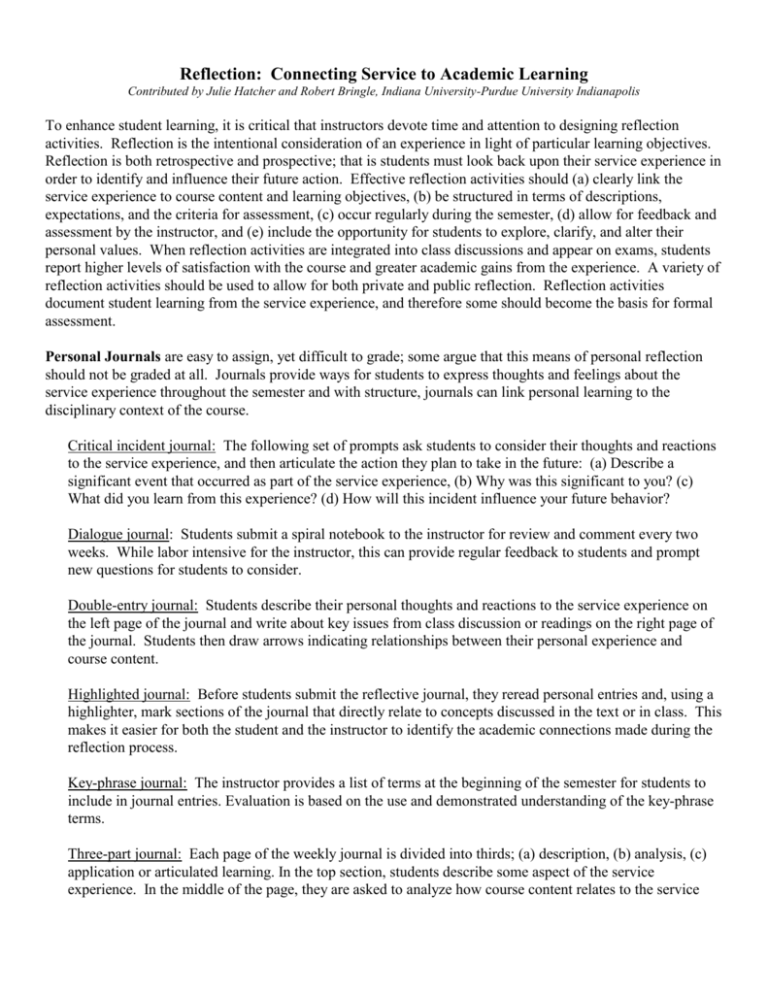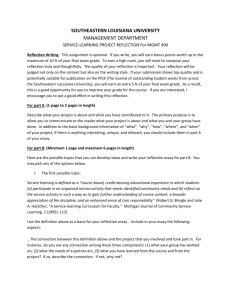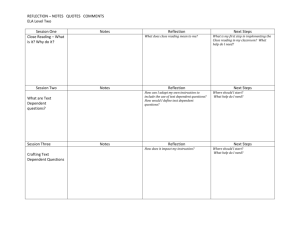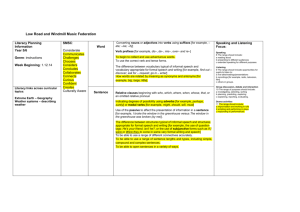Reflection - Tennessee State University
advertisement

Reflection: Connecting Service to Academic Learning Contributed by Julie Hatcher and Robert Bringle, Indiana University-Purdue University Indianapolis To enhance student learning, it is critical that instructors devote time and attention to designing reflection activities. Reflection is the intentional consideration of an experience in light of particular learning objectives. Reflection is both retrospective and prospective; that is students must look back upon their service experience in order to identify and influence their future action. Effective reflection activities should (a) clearly link the service experience to course content and learning objectives, (b) be structured in terms of descriptions, expectations, and the criteria for assessment, (c) occur regularly during the semester, (d) allow for feedback and assessment by the instructor, and (e) include the opportunity for students to explore, clarify, and alter their personal values. When reflection activities are integrated into class discussions and appear on exams, students report higher levels of satisfaction with the course and greater academic gains from the experience. A variety of reflection activities should be used to allow for both private and public reflection. Reflection activities document student learning from the service experience, and therefore some should become the basis for formal assessment. Personal Journals are easy to assign, yet difficult to grade; some argue that this means of personal reflection should not be graded at all. Journals provide ways for students to express thoughts and feelings about the service experience throughout the semester and with structure, journals can link personal learning to the disciplinary context of the course. Critical incident journal: The following set of prompts ask students to consider their thoughts and reactions to the service experience, and then articulate the action they plan to take in the future: (a) Describe a significant event that occurred as part of the service experience, (b) Why was this significant to you? (c) What did you learn from this experience? (d) How will this incident influence your future behavior? Dialogue journal: Students submit a spiral notebook to the instructor for review and comment every two weeks. While labor intensive for the instructor, this can provide regular feedback to students and prompt new questions for students to consider. Double-entry journal: Students describe their personal thoughts and reactions to the service experience on the left page of the journal and write about key issues from class discussion or readings on the right page of the journal. Students then draw arrows indicating relationships between their personal experience and course content. Highlighted journal: Before students submit the reflective journal, they reread personal entries and, using a highlighter, mark sections of the journal that directly relate to concepts discussed in the text or in class. This makes it easier for both the student and the instructor to identify the academic connections made during the reflection process. Key-phrase journal: The instructor provides a list of terms at the beginning of the semester for students to include in journal entries. Evaluation is based on the use and demonstrated understanding of the key-phrase terms. Three-part journal: Each page of the weekly journal is divided into thirds; (a) description, (b) analysis, (c) application or articulated learning. In the top section, students describe some aspect of the service experience. In the middle of the page, they are asked to analyze how course content relates to the service experience. Finally, in the application section, students comment on how the experience and course content can be applied to their personal or professional life or articulate learning derived from critically thinking about the experience. Class presentations can range from a three-minute update that occurs each month to a thirty-minute formal presentation that includes a final analysis of the service experience and offers recommendations to the agency for future work. Agency personnel can be invited to hear final presentations, if appropriate. Directed writings ask students to consider the service experience within the framework of course content. The instructor identifies a section from the text book or class readings (e.g., quotes, statistics, key concepts) and structures a question for students to answer in a 1-2 page response paper. A list of directed writings can be provided at the beginning of the semester or regularly posted on-line. E-mail discussion through on-line course management systems (e.g., Blackboard, OnCourse) can facilitate reflection with the instructor, peers, and perhaps the community agency supervisor. Students write weekly summaries, respond to a prompt from the instructor, or discuss critical incidents which occurred at the service site. Students can rotate as a moderator and summarize key concepts that have emerged from the discussion each week. A log of the threaded discussions can be printed as data about participation in discussions and the learning that was documented from the service experience. Experiential research papers ask students to identify an underlying social issue they have encountered at the service site. Students then research the social issue using traditional research methodology. Based on their personal experience and academic research, students make recommendations to the agency for future action. Class presentations of the experiential research paper can culminate semester work. Ethical case studies give students the opportunity to analyze a situation and gain practice in ethical decision making as they choose a course of action. Students can write up a case study of an ethical dilemma they have confronted at the service site, including a description of the context, the individuals involved, and the controversy or event that created the ethical dilemma. Case studies are reviewed in class and students discuss the situation and identify how they would respond. Entrance/Exit Cards are brief 3 x 5 note cards turned in at the beginning or end of each class period. Students are asked to reflect on disciplinary content from a reading assignment or class discussion and explain how this information relates to their service experience. Service-learning portfolios contain evidence of both processes and products completed and ask students to assess their work in terms of the learning objectives of the course. Portfolios can contain any of the following: service-learning contract, weekly log, personal journal, impact statement, directed writings, photo essay, products completed during the service experience (e.g., agency brochure, lesson plans, advocacy letters). Students write an evaluation essay providing a self-assessment of how effectively they met the learning objectives of the course. E-portfolios provide a web-based documentation of student learning through a student webpage.





